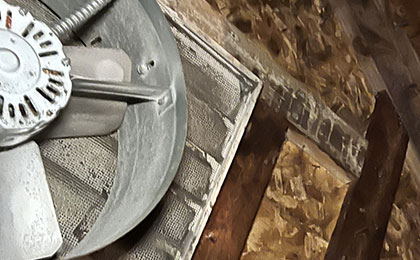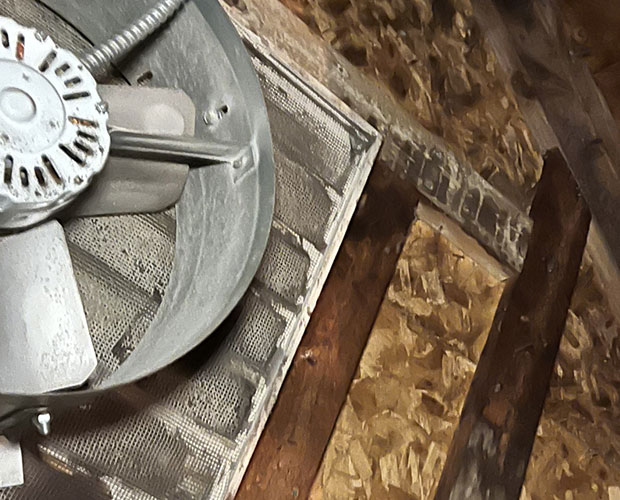
How to Remove Mold From the Attic
Lots of homeowners have mold in their attics and don't even think about it until they see it with their own eyes. The first thing that likely crosses their minds when they notice it is: "How can I get rid of mold in my attic?" First, don't panic. Second, start thinking strategically.
Mold is a fungus, and many homeowners have to deal with it at some point. It's good that you discovered the mold while it's still in your attic and hasn't yet made its way onto your ceiling or into other rooms of your home. That's great news! But where do you start? Let's go through this article and discuss how to tackle this issue step by step.
The Role of Attic Humidity and Moisture Problems
Before we dive into removal methods, it's essential to understand what mold in the attic is and why it often thrives on plywood. This will help us grasp the issue better and make it easier to choose the right treatment solutions.
First, let's talk about what happens in an attic. Think of your attic as an extension of the outdoors. If it's 80% humidity outside, it's likely 80% humidity in the attic. If it's 90°F outside, your roof space will reflect that temperature. On the other hand, if it's freezing outside with 20% humidity, the attic is likely to reflect those conditions.
The problem arises when there's a temperature or humidity difference between the attic and the outdoors. When this happens, water vapor in the air condenses on the coldest surfaces, like plywood and wooden rafters. These are the areas where mold stains are most commonly found.
When there are issues with humidity control and moisture due to poor ventilation or improper attic insulation, such conditions create the perfect environment for microbial growth. Until these mold-causing issues are resolved, then your efforts to remove the mold will be futile and short lived.
Where to Look for Mold in Your Attic
Let's go through a list of areas in your roof space that need attention to identify potential sources of mold:
- Roof Leaks: Any gaps in your roof can let moisture seep in. Even without visible leaks, nails in the attic plywood can become problematic. On the roof's north side, lacking sunlight in winter, temperature differences between the roof space and outdoor air cause water vapor to condense around these nails. This dampness creates ideal conditions for mold to grow on the plywood.
- Soffit Vents: If these small vents are blocked, airflow is restricted. Without proper ventilation, warm, humid air can accumulate, leading to moisture buildup on nearby surfaces. Over time, this excess moisture encourages mold in the attic to grow on surrounding materials.
- Gable Vents and Roof Vents: Like soffit vents, blocked gable and roof vents can also lead to mold growth. When these vents are obstructed, air circulation in the roof space is significantly reduced. This lack of ventilation traps moisture, allowing condensation to form on the inner roof surface and encouraging mold to thrive on attic plywood.
- Bathroom and Kitchen Fans: If these fans aren't properly vented to the outside, they can discharge moist air into the attic space, creating additional moisture problems.
It's essential to check all these areas thoroughly to ensure nothing is overlooked.
Attic Mold Removal Process
Once you've resolved the ventilation and moisture issues in your attic, the next step is removing the mold stains. Here's how:
1. Evaluate the Extent of the Mold Growth
It's essential to evaluate the size of the infested area. If the mold bloom covers more than 10 square feet, the CDC recommends hiring a professional remediation company. This is because airborne mold spores can pose serious health risks, and working in the attic - an area often surrounded by nails - can be hazardous.
2. Shield Yourself From Mold Exposure
Safety gear is a critical component of the attic mold treatment process. This includes:
- A high-quality mask with advanced filtration to prevent inhaling fungal spores.
- Goggles that don't fog up, ensuring clear vision throughout the process.
- Rubber gloves that are durable and won't tear.
- Protective clothing to shield your skin from mold exposure.
These precautions not only protect your health but also ensure that the job is performed safely and thoroughly.
3. Containment
Before applying any mold remover, it's essential to establish proper containment of the work area. This step prevents fungi spores and excess solution from spreading to other parts of the attic or home. Even if it might seem unnecessary, containment is a crucial precaution that minimizes potential contamination and ensures the mold cleaning process is both safe and effective.
4. Attic Cleanup With Proper Mold Remover
Next, it's time to apply the appropriate solutions to the mold on plywood and rafters. The choice of solution is critical because using an ineffective product can render the entire attic mold removal process futile. Let's discuss the most appropriate options for this:
Eco-Friendly Mold Solutions
Vinegar and baking soda are widely available and effective eco-friendly remedies. The acidity of vinegar works to break down mold, while baking soda enhances cleaning. To prepare, take one bottle of vinegar (500 ml or 17 ounces) and another bottle with the same quantity of hot water mixed with 1-2 tablespoons of baking soda. First, apply the vinegar until the surface is damp, then follow with the baking soda mixture.
To tackle black mold on attic plywood, you'll need a larger volume of liquid but must maintain the same proportions. Scrubbing with a brush or wiping with a damp cloth may be required, and the process might need to be repeated several times for visible results. This method can take time, and wearing an N95 mask is advisable, as the vinegar smell is strong, but it remains an eco-friendly option.
Commercial Mold Removers
The market offers numerous commercial mold removers, such as Concrobium, RMR, or Mold Control. Choose a product that fits your budget and includes a preventive spray from the same manufacturer for long-term protection. Removing mold in attics will often require large volumes of the mold treatment solution, sometimes several gallons due to the size of the affected area.
Repeat applications may be necessary for persistent mold stains, ensuring the surface is fully treated, especially black mold in attic. Follow up with a preventive spray after removing the mold to inhibit its return and protect the cleaned surfaces. Safety measures are essential when working with toxic mold removers, as they can be as harmful as the mold itself.
5. Reach Every Mold Stain
The application process is typically carried out using a sprayer and often requires multiple rounds because mold stains can be stubborn and difficult to eliminate completely. It's important to note that fungi tend to hide in hard-to-reach areas where air circulation is insufficient. These hidden spots must not be overlooked, as even a small, missed patch can lead to mold regrowth over time.
In some cases, reaching all the mold may require removing attic insulation or even disassembling parts of the roof space. While this can be timeconsuming, it is well worth the effort. Not treating the entire affected area will result in the mold returning, meaning you'll eventually have to revisit the problem. Addressing the issue thoroughly the first time is always the better approach.
6. Preventive Measures
At this stage, the focus shifts to preventing attic mold in the future. This will likely involve some construction work. Here are the key modifications to consider:
- Extra Fans for Gable Vents: Installing electric fans in your gable vents can significantly increase airflow and improve attic ventilation. With better ventilation, issues like damp air caused by varying weather conditions are minimized, as these fans are designed to operate effectively in all climates.
- Additional Roof and Soffit Vents: Adding more roof vents and soffit vents is another effective way to improve airflow. However, this modification often requires professional assistance to ensure vents are installed correctly in the optimal locations. Proper installation is crucial for maximizing ventilation and preventing future mold growth.
- Dehumidifier: A dehumidifier is a reliable solution for managing humidity levels. It helps maintain a dry attic environment by quickly addressing any moisture that might accumulate, further reducing the risk of mold.
- Sealing Air Leaks: Fixing potential air leaks might seem like a minor detail, but it's essential. While one small air leak might appear insignificant, multiple leaks can drastically affect attic humidity. Warm air rising through holes in the attic floor interacts with the cold roof surface, creating condensation and promoting mold growth. Sealing these leaks effectively minimizes temperature fluctuations and helps protect attic plywood from future mold problems.
Should You Do It Yourself or Hire a Professional?
Once you understand how to clean mold off your attic, the next step is deciding whether to do it yourself or hire a professional. This is a crucial decision because the responsibility ultimately falls on you. On one hand, handling it yourself might save money. On the other hand, it could cost you more in terms of time, effort, and the risk of mistakes due to inexperience. So, why might professional help be a better option?
Consider this: you already spend your week solving tasks within your area of expertise, and you're good at it. Tackling a new challenge, like attic mold removal, is something you can certainly figure out, but at what cost? Let's break it down:
- Time: Mildew removal is a completely new task, which means you'll need to dedicate time to educating yourself on how to do it properly, as well as additional time to execute it.
- Safety Gear, Tools, and Solutions: You'll need to research and choose the right safety equipment, tools, and black mold removal products. This can be time - consuming, especially if you're unfamiliar with what's needed.
- Learning Curve: The first attempt at anything is always more challenging and takes longer than anticipated. You're likely to encounter mistakes along the way, and fixing those mistakes can eat up even more of your time.
When you add up the time required to learn, purchase equipment, and correct any first-time errors, you may find yourself questioning whether it's worth it. If attic mold removal isn't your area of expertise, wouldn't it be better to focus on what you're already skilled at?
By investing your time in your profession, you could generate income and build experience in what you do best - possibly earning enough to cover the cost of mold remediation in your attic easily. Hiring a professional allows you to save time, reduce stress, and ensure the job is done thoroughly and effectively.
Choosing the Pros for Attic Mold Removal
Attic mold removal is a task that homeowners can tackle with enough time, effort, and a willingness to learn. However, while it's easy to read or watch tutorials on attic mold treatment, executing the job is an entirely different challenge. Hiring a professional mold remediation company, like Mold Act, is not just reasonable - it's a wise choice. Mold in the attic requires attention, but it can be resolved effectively with the right approach.
Whether you choose to handle it yourself or bring in experts, addressing the root causes and taking preventive measures is essential. With over 20 years of experience, Mold Act has mastered the process, ensuring attic mold is removed thoroughly and efficiently. Your time and peace of mind are valuable, and professional remediation may ultimately be the smartest decision to ensure a safe, mold-free home.



Mold Remediation Services

